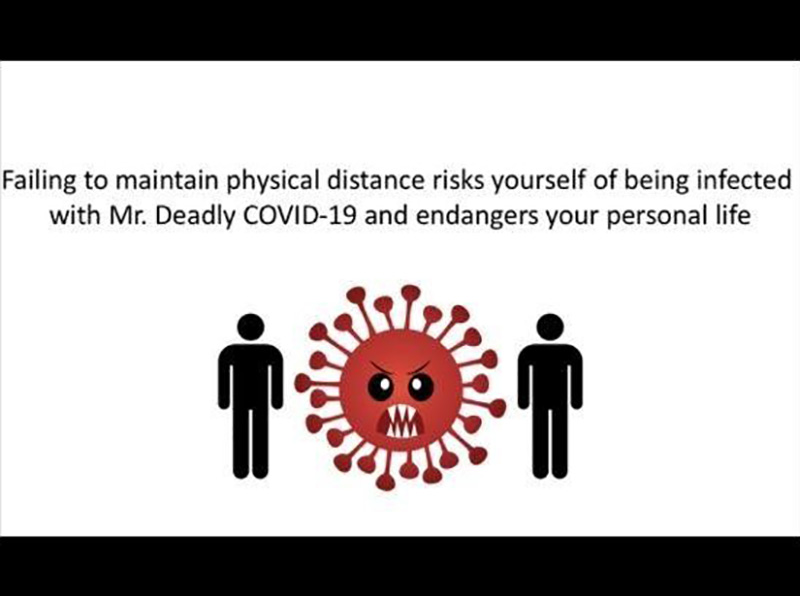Compiled by veteran medical journalist Brian Owens, this roundup of some of the newest science on the COVID-19 pandemic, straight from the scientific journals, is presented by Hakai Magazine in partnership with The Tyee.
How long are people infectious?
A review of dozens of scientific studies has determined that although the SARS-CoV-2 virus may be detectable in patients for prolonged periods after infection — weeks or even months — they are only infectious for a much shorter time. People with mild or no symptoms of COVID-19 are infectious for no more than 10 days, while those with a more severe course of the disease remain infectious for up to 20 days after symptoms appear.
Infection Control and Hospital Epidemiology, Oct. 20, 2020
Universal mask wearing could save hundreds of thousands of lives
There could be more than half a million deaths in the United States from COVID-19 by the end of February 2021, according to a modelling study. But if 95 per cent of the population always wears a mask in public, that toll could drop by up to 25 per cent, saving 130,000 lives. Another study, by researchers at Simon Fraser University that has yet to be peer reviewed, found that rules requiring the use of masks are associated with a 25 per cent or larger weekly reduction in new COVID-19 cases.
Masks greatly reduce the size of the clouds of droplets released by infected people. One study found that the size of the “cough cloud” without a mask is about seven times larger than with a surgical mask, and 23 times larger than with an N95 mask. The effectiveness of homemade cloth masks can be improved by using a non-woven material such as cotton batting. This increases the surface area of fibres exposed to moving air and improves filtering efficiency, because the smaller particles are absorbed into the fibres.
Nature Medicine, Oct. 23, 2020
MedRxiv, Oct. 16, 2020
Physics of Fluids, Oct. 20, 2020
Risk Analysis, Sept. 24, 2020
Open windows and glass screens can help keep classrooms safe
Opening the windows in a classroom causes 40 per cent more exhaled aerosol particles to leave the room, and glass screens in front of desks can help disrupt the flow of these particles. Different places in the room also have different levels of risk — the back corners are the safest, according to the researchers — so children at higher risk of complications from COVID-19 could be seated there for extra protection.
Physics of Fluids, Oct. 20, 2020
Second cellular receptor for COVID-19 discovered
The SARS-CoV-2 virus is known to use the ACE2 receptor to penetrate human cells, but now researchers have discovered a second receptor that the virus also targets, called neuropilin-1. This second receptor could help explain why COVID-19 spreads more easily than the similar SARS virus from 2003, and provides another potential target for treatments.
Science, Oct. 20, 2020 (1)
Science, Oct. 20, 2020 (2)
Arthritis drug doesn’t work for COVID-19
The drug tocilizumab, which is commonly prescribed for rheumatoid arthritis and other conditions, does not reduce the need for mechanical ventilation or prevent death from COVID-19. Severe cases of COVID-19 are associated with a “cytokine storm” — an excessive immune response that is damaging rather than protective. Tocilizumab blocks one of these cytokines, so was considered a potential way to prevent the storm, and some early studies suggested it might be effective. But a more thorough study found it has no effect.
The New England Journal of Medicine, Oct. 21, 2020
Pooled testing can screen populations cheaply
A mathematical algorithm that can screen large groups of people for COVID-19 could be around 20 times cheaper than individual testing. In this method, tiny quantities taken from individual swabs are mixed to create combined samples and then tested. If this initial test finds that the mixed sample contains positive cases, the algorithm is able to pinpoint individual positive swab results within the combined sample. This method is best suited for regular screening of the population, and has already been used successfully to screen air passengers in Rwanda, and a rugby team in South Africa.
Down syndrome increases risk of death from COVID-19
Down syndrome is not mentioned on any official lists of conditions that increase the risk from COVID-19, but the syndrome is associated with heart and lung problems, and immune dysfunction. A study in the U.K. found an estimated four-fold increased risk for COVID-19-related hospitalization, and a ten-fold increased risk for COVID-19-related death in people with Down syndrome.
Annals of Internal Medicine, Oct. 21, 2020
Fear and anthropomorphism can improve compliance with COVID-19 rules
Despite a plethora of signs and public service announcements, many people still fail to follow guidelines around physical distancing and mask wearing. A study has found that adding two components — negativity and anthropomorphism (giving non-human objects human characteristics) — can help improve compliance. In a hypothetical supermarket scenario, people responded better to messages that highlighted the negative health outcomes of failing to maintain distance, rather than the positive effects of compliance — especially when combined with a “Mr. Deadly COVID-19” scary face, with sharp teeth and angry eyebrows.
The Service Industries Journal, Oct. 19, 2020

Politicians won’t be punished for pandemic failings
Politicians are unlikely to be punished or rewarded for their failures or successes in managing the pandemic, according to a survey of people in the U.S., U.K. and India. For the survey, respondents were divided into two groups: one was given facts about the economic and health impacts of the pandemic in their country, while the other was not. Respondents were then asked about their attitude towards their government, and their voting intentions. While more than half of respondents thought their government was to blame for the spread of COVID-19, those given key facts about the pandemic were no more likely to favour or disfavour the incumbent government, or blame it for the pandemic, than those in the comparison group.
BMJ Global Health, Oct. 23, 2020
The death rate is declining
Fewer people are dying from COVID-19 than expected, according to a study of patients in New York City. In March, more than 25 per cent of those hospitalized with COVID-19 died from the disease, but by August the death rate had dropped to just above seven per cent. The decline in deaths is due to improvements in treatment, and to the fact that younger, healthier people now make up a larger proportion of hospitalized patients than in the spring.
Journal of Hospital Medicine, Oct. 23, 2020
Social connections influence compliance with rules
People in U.S. counties with more social connections to China and Italy (as measured by Facebook friends) were more likely to adhere to physical distancing restrictions in the early stages of the pandemic, suggesting that social networks supplied pandemic-related information that influenced individual behaviour. But social connections could also have a negative influence: areas with more connections to counties with low education levels, high proportions of 2016 Trump voters, and high proportions of climate change deniers, had less adherence to mobility restrictions.
Science Advances, Oct. 23, 2020

Immune response linked to disease severity. But how long does it last?
People who experienced more severe disease from COVID-19 generate a stronger immune response than those with mild disease. But in both cases, the antibodies wane after about three months, according to a study in the U.K. Another study in Portugal, which also linked immune response to disease severity, however, found that antibodies could still be detected up to seven months after infection.
Nature Microbiology, Oct. 26, 2020
European Journal of Immunology, Oct. 21, 2020
How the virus is evolving
Parts of the SARS-CoV-2 virus are still mutating rapidly as natural selection seeks ways to improve its spread, while other parts have already stabilized in an optimal form. The stabilization of certain proteins, including the spike protein that the virus uses to enter cells, is both good and bad news. Bad, because it indicates the virus has found a highly effective form, but good because stable proteins make better targets for drugs and vaccines.
Evolutionary Bioinformatics, Oct. 23, 2020
Air pollution increased COVID-19 deaths by 15 per cent
Around 15 per cent of deaths from COVID-19 worldwide can be attributed to long-term exposure to air pollution. In Europe, the proportion was about 19 per cent, in North America it was 17 per cent, and in East Asia about 27 per cent. Researchers say there is not necessarily a direct cause-and-effect relationship between pollution and mortality, but the pollution is likely to exacerbate underlying health conditions that could lead to worse outcomes from the virus.
European Heart Journal, Oct. 26, 2020 ![]()
Read more: Coronavirus, Science + Tech















Tyee Commenting Guidelines
Comments that violate guidelines risk being deleted, and violations may result in a temporary or permanent user ban. Maintain the spirit of good conversation to stay in the discussion.
*Please note The Tyee is not a forum for spreading misinformation about COVID-19, denying its existence or minimizing its risk to public health.
Do:
Do not: